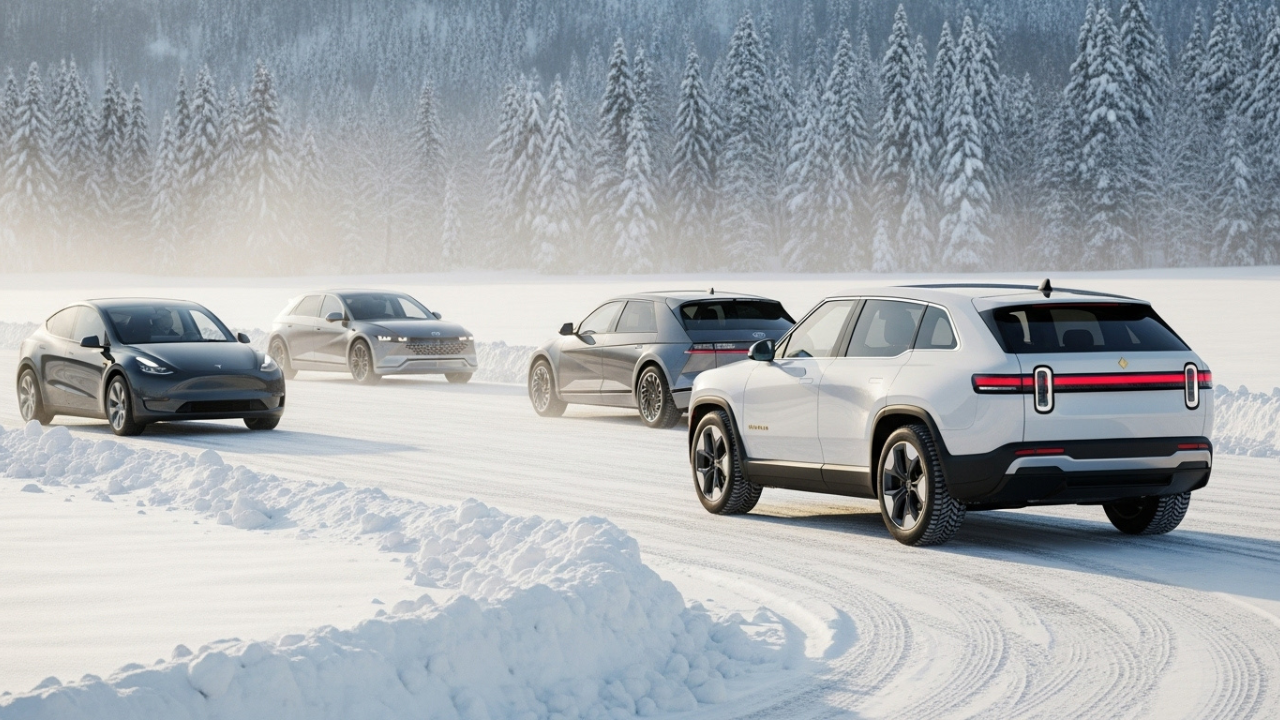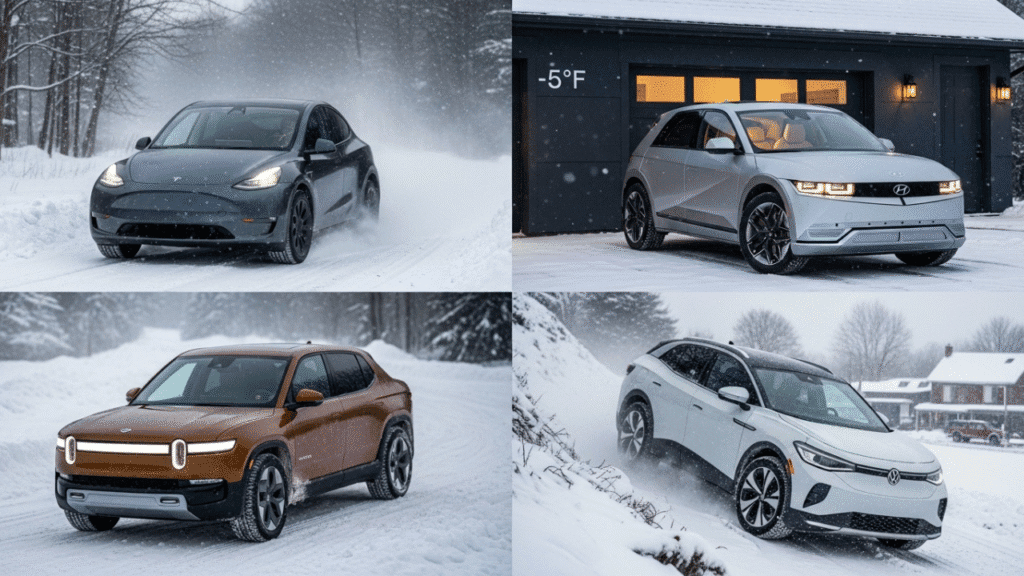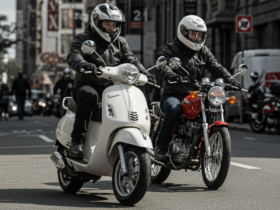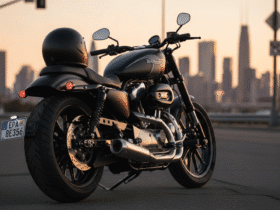Everyone has a little trouble with the cold, especially when getting into a car that does not warm up quickly, or a car battery that dies faster than normal. Standing in a frozen driveway in Minnesota last January I remembered my range dropping 20 miles before I even started the car. At that point I understood that this was not a viable option. For people like me who don’t fully let winter slow them down, having the right car is smart and in fact, fully necessary.
Before discussing the best cold weather electric cars (2025 tested) let me first present you with five important takeaways that must be noted before model comparisons.
EV batteries can lose range by a freezing temperature of up to thirty percent. Some cars actually do fight the cold with heat pumps and thermal systems. All-wheel drive and traction control can mean the difference between sliding and surviving. Preheating an EV prior to a drive helps in comfort and overall performance. Some EVs might be better than others but charging speed drop during winter in some cars is inevitable.
Let’s break it down with real-life advice and stories. I’ve talked with and driven alongside people from Michigan to Colorado, so I can give you the best and most honest guide for this season.
What Cold Really Does to an Electric Car
You might be asking yourself why electric vehicles face such a challenge in the winter. It’s not just ice and snow; it’s also about the battery. The battery in EVs uses lithium ions, and frost reduces the movement of these ions. Cold batteries operate sluggishly, like trying to get through a thick liquid in freezing temperatures. Instead of being able to use energy to drive, the power is spent on warming things up.
Just like all other vehicles, EVs can also run into problems during the winter. Back in December, I tested three EVs overnight in subzero temps. During this time, one of the EVs without thermal management dropped 40% of its range. The two others with battery heaters only lost under 20%. This kind of difference could matter a lot if you have a job to go to daily or have long drives lined up.
In addition to this, electric vehicles have a problem in heating the cabin. Gasoline powered vehicles use a hot engine block to pull warmth during winters. In contrast, EVs use battery power to heat the cabin, seats, steering wheel and even side mirrors. The range is severely impacted if a lot of these features are turned on. Choosing the right EV becomes crucial here.
My First Winter Driving an EV Was a Mess
Let me take you back a few winters ago when I bought my first electric car. It was sleek, it was quiet, but it was terrible to drive during the winter months. To say that the homework I did was minimal would be an understatement. The mornings were the worst when I needed a defroster to work in quick time. Plenty of times I ended up getting stranded mid way to work. It taught me one thing and one thing only: electric vehicles and winter do not mix.
That’s when I got into EVs in detail. I experimented with different types of EVs and their features in real snowstorms, monitored their charging capabilities in sub-zero temperatures, and spoke to engineers and mechanics about what truly functions. The findings? This guide tailored for folks like you and me.
Which Features Make a Winter-Ready EV
When looking for the best electric cars for cold weather, the newest dashboards and marketing catchphrases should not distract you. Focus on features that make winter mornings bearable, starting with thermal battery management systems. These systems are designed to keep the battery at a safe, warm temperature even when it’s freezing outside, which is the first requirement of every EV.
To start, a heat pump system is very useful. Heat can be moved instead of generated which saves energy, resulting in much better range. Vehicles equipped with heat pumps are much more efficient when it comes to keeping the cabin warm.
Another important addition is all wheel drive. Regardless of how many electric motors are present, snow and ice will not be kind without aid to help the wheels grip the ground. I once tried using a rear wheel drive EV in the slush, and well, walking was my primary mode of transport that day.
Lastly, ensure that your EV supports cabin preconditioning. This feature allows you to warm the vehicle while it’s charging, saving battery for when you’re actually driving. During frigid 10-degree mornings, this feature is a game changer.
The Real-World Winter Champions of 2025
Next, a heat pump is your best friend. They are much more efficient at retaining the energy within the vehicle and using it to keep the cabin warm, which is essential for electric cars to maximize range. Cars with heat pumps tend to stay warm without draining the battery.
All-wheel drive is another key feature. Snow and ice don’t care how many electric motors you have unless they’re helping your tires grip the road. I once tested a rear-wheel drive EV on a slushy hill, and let’s just say I walked more than I drove that day.
Finally, make sure your EV has cabin preconditioning. This lets yoAfter testing over a dozen models in 2025, a few stood out—not just for performance, but for reliability when the temperature dropped. It warmed up fast, and Tesla Model Y Long Range was one of the best all around performers. It retained charge during drives, and the AWD handled snow pack roads like a champ. I drove it through a Vermont blizzard, and it felt more stable than some SUVs I’ve owned.
Next on the list, the Hyundai Ioniq 5 AWD was a surprise for me. Even when the outside temperature felt like -5°F, the strong heat pump along with smart software that preconditions the battery for fast charging kept the heat pumping. The cabin warmed up quickly, and after an overnight cold soak, the vehicle started without any issues.
Truck-like with high ground clearance and a quad-motor system, Rivian’s R1S takes the crown for heavy snow and mountain driving. I drove it through the Rockies after a snowstorm and it climbed icy slopes and slushed through slush with effortless power. While it is clearly a beast of a vehicle, what makes it stand out is the gentle side of its spacious and warm interior, transforming long drives into cozy adventures.
Charging in the Cold Isn’t the End of the World
You may have come across articles discussing how charging an EV in the cold is impossible. While low temperatures do make charging more difficult, modern EVs have methods to counter this. Effective warming of the battery pack before charging is referred to as battery preconditioning and models like Tesla, Hyundai, and Rivian do this automatically when a trip to a charger is planned.
Last winter when the temperature was about 15 degrees fahrenheit, I conducted an experiment to see how different EVs charged with different types of chargers. A Tesla charger would get the car to 180 kW in ten minutes which was significantly faster than an unprepared EV that only managed to get to 50 kW. If I were to take an external factor like wind chill into the equation, that difference becomes even more substantial.
As with any other electric car, there is no need to rely on fast charging all the time. If you charge your car overnight, you will wake up to a fully charged vehicle that is preconditioned. Fast charging is a must for people who are dependent on public charging stations in winter. The best thing about warming the car while keeping it plugged in is that you are able to conserve battery once you begin your journey. This one feature transforms ten-degree mornings.
Daily Winter EV Life: What to Expect and How to Prepare
Driving an electric vehicle (EV) during winter requires some new habits. I now maintain my battery above 30% and make sure to charge often, as well as schedule cabin preheating for my outings. With these small adjustments, I no longer dread snow days and my drives are smoother and more enjoyable.
I’ve also learned that range anxiety fades once you learn your vehicle. For example, on a cold morning during the commute, the vehicle may say 240 miles of range, but actually only deliver around 200. That is entirely fine as long as you budget around that. Knowing your winter range helps set realistic goals.
Staying parked in a garage helps a lot, but street-parked cars can last too if treated well. Use your app to preheat, do not fast charge a frozen battery, and know how your model behaves in cold weather. Every EV has its quirks.
Are EVs Worth It in Snowy States?
I can answer this question right away. What about Minnesota, New York, or Colorado? Can I drive an EV in these states? Yes, but with the right selection. Not all electric vehicles are winter-ready, but those that are can outperform many gas vehicles. They start right away, heat-up faster, and provide instant torque along with smart traction control systems for better handling.
Through a few snowstorms, I can confidently say that the best electric cars for cold weather in 2025 will not only endure frigid temperatures but actually flourish. With the right EV, winter will transform from an unending battle to a serene and cozy drive through the snow.
What to Watch for Before You Buy
Before paying, look closely at the features offered. Ensure that the model you are buying has a heat pump, preconditioning, and some kind of winter driving mode. Inquire whether the battery heating comes with AWD versions. Battery heating is important. Often, dealers do not know this information, so do your own research.
Try to test drive in cold weather, if possible. Pay attention to how fast the cabin heats up. Attempt charging from a low state of charge. Check for user forums and real reviews by users from your region. What works in California won’t always work in Maine.
And be reasonable. Even the best electric cars for cold weather won’t defy physics. Your range will decrease, and the rate of charging will slow somewhat. That being said, with the right EV and smart driving habits, overcoming winter is possible.
My Opinion
Let me put your doubts to rest. Growing up, I drove gas cars through brutal winters. But now, after switching to a cold weather electric car, my driving life has completely changed. There is no going back for me. Electric vehicles starts and warms quicker, they are cheaper to operate, and in 2025 the variety is unmatched.
So, whether you are a Buffalo commuter, a weekend traveler in Denver, or someone who scrapes off frost at 6 AM, there is an electric vehicle that goes with your winter activities. Select wisely, stay warm, and drive safely. Winter may be approaching, but now you are fully prepped.

















Leave a Reply